
10 Ways I've Been Using Linkscape to Help Our SEO Projects
The author's views are entirely their own (excluding the unlikely event of hypnosis) and may not always reflect the views of Moz.
Linkscape has been out for just over 2 months and recently had its first index update. Although it's still in beta (and probably will be for another update or two), I've been using it enough for our client projects that I think it's worthwhile (and high time) to share my personal applications for the tool and its data.
#1 - Comparative Reporting for Management
CEOs, CMOs and Director-level types tend to have a thirst for KPIs (Key Performance Indicators). Yahoo! Site Explorer has historically been the preeminent source for link numbers, but it's always had problems, not least of which is the massive fluctuations (hit F5 in your browser a few times and the numbers that come back are seemingly random). Linkscape's index, although it's less frequently updated, gives a reliable snapshot from representative sample of the web's links. The only time that data changes is when the index updates.
Below is an example of what I'd prepare if we were working with Zappos.com and wanted to show my board of directors our stats against those of top competitors:
|
DmR (Domain mozRank) |
# of External Links |
# of Linking Subdomains (FQD: Fully Qualified Domain) |
# of Linking Domains (PLD: Pay-level Domain) |
|
| www.zappos.com |
7.01 |
329,180 |
8,376 |
7,142 |
| www.shoes.com |
6.20 |
16,444 |
2,070 |
1,793 |
| www.shoebuy.com |
6.35 |
390,724 |
2,063 |
1,749 |
| www.payless.com |
5.97 |
30,831 |
2,202 |
1,957 |
| www.endless.com |
5.50 |
6,950 |
1,189 |
960 |
I've got some fast, easy takeaways from this data. First off, we're winning not only the link numbers battle, but the importance battle as well. A raw count of external links actually shows Shoebuy.com ahead of Zappos, but when we look at the domain diversity ('# of External Links' divided by '# of Linking Domains ), we can clearly see that Zappos is in the lead. Secondly, I know exactly how far a relatively new player like Endless.com has come - they've been here almost two years and clearly haven't threatened even some of the smaller competitors in the field. Interestingly, DmR (Domain mozRank) matches up pretty nicely with rankings, too - Google results. I'd be more inclined to look at things like page-level mozRank, # of links to the URL and anchor text, but it's still fun to see such high correlation.
Compare this to a classic report using search engine data:
|
PageRank of Homepage |
# of Links (Yahoo! Web Search) |
# of Links (Yahoo! Site Explorer) |
|
| www.zappos.com |
8 |
5,830,000 |
2,962,175 |
| www.shoes.com |
5 |
44,200 |
217,087 |
| www.shoebuy.com |
8 |
4,640,000 |
3,216,536 |
| www.payless.com |
6 |
22,300 |
49,076 |
| www.endless.com |
7 |
1,610,000 |
599,200 |
Collection methodology for Yahoo! was to use the web search "linkdomain:domain.com -site:domain.com" and use "show inlinks except from this domain to entire site" in Yahoo Site Explorer.
The homepage PR has always been a crummy metric (and one that considers only that single page, rather than the entire domain), so having DmR is a big step up. Likewise, it's hard to convince SEO outsiders (or insiders, for that matter) that Yahoo!'s link reporting data is valid when it's frequently extremely different from the numbers inside Google's Webmaster Tools (which can't be used for competitive comparisons since you can't log in to other sites' consoles) and even different from different types of Yahoo! requests. Honestly, Yahoo! isn't even consistently inconsistent, so despite fresher data and a larger index, the numerical discrepancies make it nearly impossible to use for serious analysis.
#2 - Analysis of the SERPs (aka figuring out why a page ranks where it does in relation to others)
I'm always curious to understand how a site/page has achieved the rankings it has, and Linkscape is marvelous at taking a lot of the unknowns out of the equation. We can all look at keyword usage and targeting, but getting into the link analysis on competitive SERPs has always been incredibly difficult. Now (especially with the new Linkscape update showing more links per report - 3,000 for the URL at once), I feel really confident about the assessments I make as to why a site is succeeding or failing.
For example, if I wanted to analyze the top 5 ranking URLs for the phrase "Free Ringtones," I can do so with a lot of strong data points:
|
URL |
URL |
# of |
# of |
Domain |
# of |
# of |
|
| www.brinked.com |
5.21 |
3.34 |
1,584 |
190 |
4.11 |
1,601 |
190 |
| www.mytinyphone.com |
5.69 |
4.25 |
12,866 |
208 |
4.55 |
14,672 |
299 |
| www.myxer.com |
5.57 |
4.55 |
4,682 |
635 |
5.90 |
11,208 |
955 |
| www.phonezoo.com |
5.37 |
2.95 |
1,424 |
488 |
5.04 |
2,096 |
597 |
| www.tones9.com |
6.49 |
4.81 |
49,003 |
321 |
4.85 |
51,301 |
321 |
Naturally, I'd want to add in keyword usage and optimization information, but it's normally sorely lacking that big anchor text component. With Linkscape, I can finally fill in that missing blank and have a real idea about the quantity/percent of links that contain optimized anchor text:
|
KW (Keyword) in Title |
KW in URL |
KW in <H1> |
# in Body Text |
# of Exact KW Anchor Text Matches in top 3K links |
# of Domains Linking w/ KW Anchor Text |
|
| www.brinked.com |
1st Words |
No |
No |
0 | 170 | 53 |
| www.mytinyphone.com |
1st Words |
No |
No |
5 | 27 | 9 |
| www.myxer.com* |
Only |
No |
Only |
0 | 2 | 1 |
| www.phonezoo.com |
1st Words |
No |
H1 |
0 | 224 | 97 |
| www.tones9.com |
1st Words |
No |
No |
3 | 448 | 149 |
* - www.myxer.com appears to have several other pages that have earned links 301 redirecting to it.
Based on an analysis like this, I can put together an extremely good estimation of what will be required to achieve competitive rankings for the keyword phrase. If you've got high value keywords you're pursuing and need to know what it will take to get there, this system is a remarkable road map.
#3 - Uncovering a Competitor's Link Acquisition Tactics
It can be frustrating to see a competitor shoot ahead in the rankings and have no idea how they've achieved their success. Linkscape makes it easy for us to reverse the tactics that have produced valuable links and good anchor text by letting us quickly sort through the links pointing to a given site/page.
For example, if I was curious about how Evosales.com (a site selling scooters and mopeds) had earned their links, I could peek inside an advanced Linkscape report and see 852 links to the domain from 277 domains. Linkscape will show only the top 10 from any given domain, so even though it has 1,315 links, it's limiting some of those that come from domains with tons and tons of links.
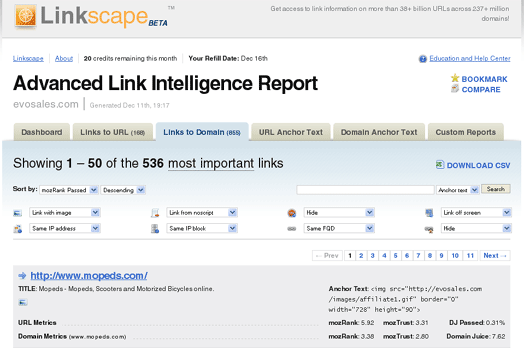
Looking at the data, I can see a lot of links that appear to come from partnerships they've got with other scooter dealers on the web like mopeds.com, neoscooters.com and iscooterparts.com. There's some nice natural links coming from Scooter forums like ScooterBBS.com, Digg.com, Kaboodle.com and AdLandPro.com. They also have a small directory link building campaign earning some juice from sites like About-Cars.com, rkom.com, motorcycleonlinestore.com and more. All in all, for a small number of links, the profile is pretty balanced and relatively organic.
For many cases, knowledge like this will help establish an understanding inside your organization of what the competition is up to. If there's lots of spammy, low quality links, you can potentially report these to the engines. If the competition has great viral content, you can attempt to mimic or outdo their efforts. And if they've simply got a small, organic footprint, you can be more aggressive with directories, content strategies and direct link requests or purchases to overcome their lead. It's always an excellent idea to be prepared and the ability to sort, filter out nofollows and internal links and see where good anchor text and link juice flows from makes this process much more accessible than with other, less granular or expansive tools like Yahoo! Site Explorer or Exalead.
#4 - Identifying the Most Important / Most Linked-to Pages on a Site
In the near future, we'll be building out a specific tool to help with this process, but in the meantime, the data is still relatively accessible through Advanced Link Intelligence reports. Just choose "links to domain," then select "same PLD" (Pay Level Domain: Entire website including all subdomains) and "show only." This will give you an ordered list of the top ten highest mozRank (or highest mozRank-passing) pages on your site. For example, I've done just this with SEOmoz's homepage below:
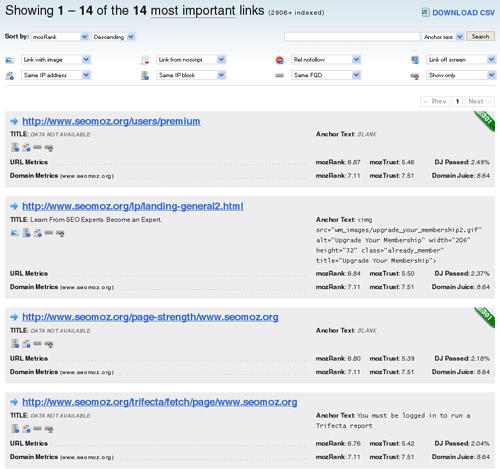
What's amazing about this kind of information is that it's so easily actionable. Looking at this, it's obvious we need to start using the link juice on the SEOmoz PRO Landing Page better (or potentially redirecting non-cookie accepting users back to the homepage, since you'll need to log in to complete the next step, anyway). Likewise, I can see that the old Page Strength tool is redirecting link juice to the Trifecta report, which probably needs some attention as well (since that page isn't trying to rank for anything competitive, either).
Running this on your own sites and pages can reveal internal architecture and link structuring mistakes that could spell huge opportunity for redirecting link juice to places where it's needed. And similarly, you can use the comparison report feature to custom-check any number of combination of pages on a site:

Comparing the URL mozRank with the link counts reveals great information - it can help to illustrate the relative success of a piece of viral content (like our Web 2.0 Awards against our Search Engine Ranking Factors) from both a number of links and importance of links perspective. I can also use it to identify strong vs. weak pages and make decisions about whether to redirect, where to point links to and from and what difficulty level of keywords to target.
#5 - Finding Sources of Split Link Juice
Many sites have multiple versions of the same page for one reason or another. Oftentimes, it's tough to convince developers or management that it's a priority that needs addressing, but SEOs know from experience that it can have a big impact, particularly when the engines themselves are doing a poor job of canonicalizing for you (or haven't passed along the link juice when they scrub the duplicates). Linkscape is great at illustrating the potential problems using the comparison report.
For example, on NYTimes.com, there are four different URLs that send you to the technology home page. In fact, you can see them all in Google's index:

Wow. That's pretty telling - and even if Google is doing an OK job of getting those pages canonicalized, it's a terror to imagine trying to do analytics work on that page. You've got four different URLs you'd need to track (in Omniture or whatever analytics NYTimes is running), making for a huge headache. Let's see if Linkscape can help convince us that it's time for a move:
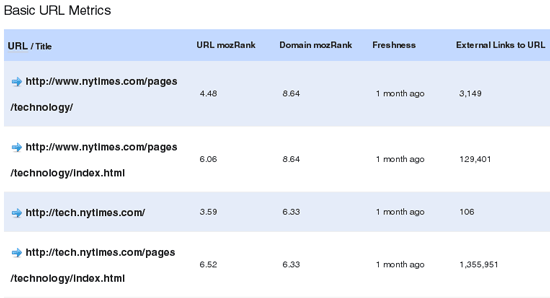
Basic Comparison Report
You can see we're looking at 4 unique URLs, all with the same content, and each earning hundreds or thousands of individual links. Put the link juice together, and the potential is remarkable. Apply this same logic to pages on your own sites (or those of your clients) for easy wins on low-hanging fruit.
#6 - Identifying Possible Spam
There are two big reasons an SEO wants to be able to see spam: first, so they can potentially identify and report their competitors for violating the search engines' guidelines, and second, to help keep their own noses clean as they conduct link building and acquisition campaigns. My favorite way to do this is to use the difference in mozRank & mozTrust to help quickly spot possibly problematic URLs and domains. If you've got lots of link juice but very little trust, it usually means you've gotten links from places that aren't particularly reputable. Since mozTrust is still a rough metric, it's best found on sites/pages where the disparity is quite large.
Let's say, for example, I'd like to rank well for "discount mortgage brokers" - which probably wouldn't be as appealing today as it was 6 months ago, but probably still gets some pretty decent search traffic. Here are some folks ranking in the top few results:

In classic SEO, I'd go look at the links pointing to these pages (and sites) and try to find some potential sources where I can also get links - directories, lists, resource hubs, etc. But, if I'm smart, I'll only spend time chasing the ones that are really worthwhile, and that's where mozRank can have a big impact. For example, if I go to the links pointing to www.wes-state.com, I'll see some good links, but I might also find some like these:
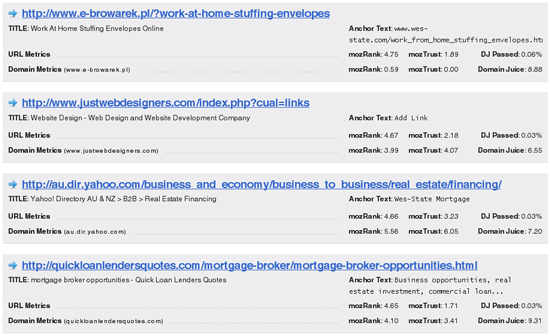
Obviously, the Yahoo! directory link is a pretty good one - high mozRank and mozTrust on both the domain and the page level. But the others, especially on a URL mozTrust level (and judging by the feel - title, URL, content, etc) might not be prime candidates. While I love Yahoo! Site Explorer, there's no fast and easy way to weed out the good from the bad as you're sorting through it, so these metrics can be a huge time saver, as well as helping to avoid money spent on links that may not provide much value (either now, or in the future).
#7 - Judging the Quality of a Potential Link
In a related way, Linkscape has also been good to help me judge the potential value of a link. Since most of our clients are larger enterprises and organizations, I'm not usually doing this on a link-by-link level. Instead, I'm applying the logic of metrics like inbound link quality and diversity (along with the specific mozRank and mozTrust scores) on a domain-wide basis.
For example, if we were working with Apple (we're not), they might want to examine the SEO value of buying up some smaller MP3 stores or fan websites and hosting those themselves, embedding their links or entirely redirecting the sites. Without numerical evaluation metrics, it would be much harder to visualize the different values of particular sites. This applies equally well to individual pages and smaller sites. Thinking about paying for a link, buying a site, putting up some advertising or engaging in a joint venture? Trustworthy metrics are an invaluable asset.
#8 - Finding Specific Link Acquisition Targets
There are a few particular queries inside a Linkscape report that I've found incredibly valuable for individual link sourcing:
- Search for "resources" in the URL
- Search for "links" in the URL
- Search for "directory" in the URL or title
- Search for "list" in the URL or title
Results may vary, but just a few quick searches can source hundreds of new link opportunities. For example, check out a search for "directory" in the title of pages linking to www.directlendingsolutions.com:

Or see the links that point to popular online comic book store tfaw.com that have "links" in the URL:
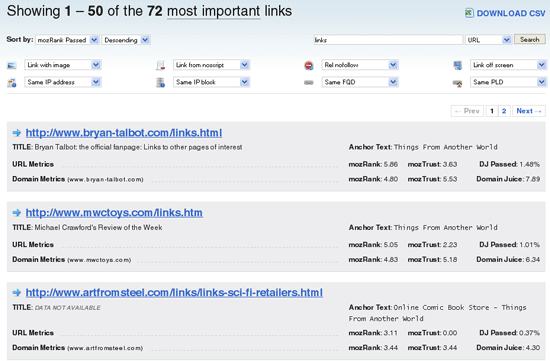
If you're hankering for an easier way to find link acquisition targets, this is a pretty spiffy system.
#9 - Judging the Relative Success of Viral Content
What worked better, my mortgage calculator or my blog post on how zombie overlords are eating the brains of Wall St.'s elite? From a traffic perspective, it's not hard to see using your site's analytics, but on the SEO side, it can be very tough to judge which content is earning more links (and higher quality links). Luckily, the comparison report simplifies the process.
Since we're on the topic of the undead, let's look at how some specific pieces of linkbait have fared in the world of vampires, zombies and their ilk:
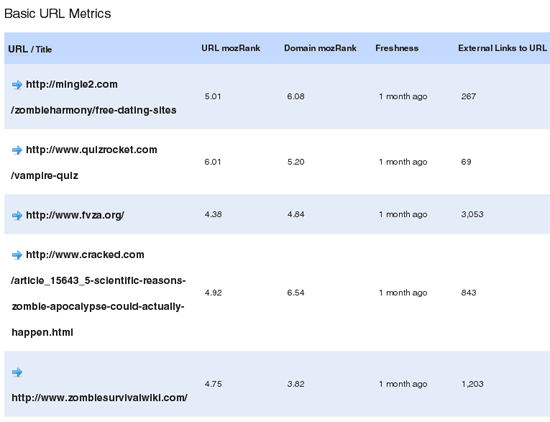
Looking at the numbers, we can see that the Zombie Survival Wiki (ZombieSurvivalWiki.com) and the Federal Vampire and Zombie Agency (FVZA.org) lead the way, although since the Mingle2.com Zombie Harmony site once existed at its own domain - www.zombieharmony.com - we should really count the 1,380 links from 412 domains that site earned as well, putting it clearly in second place.
This isn't just for fun - you can use analyses like this to see what's been successful for your competitors as well as your own site and leverage that knowledge to make informed decisions about how to best target and construct your next viral campaign.
#10 - Finding Specific Kinds of Links, Such as .edu and .gov
Just as you can use Linkscape's search function to identify directories and resource lists, you can also leverage it to locate high quality .gov and .edu website links.
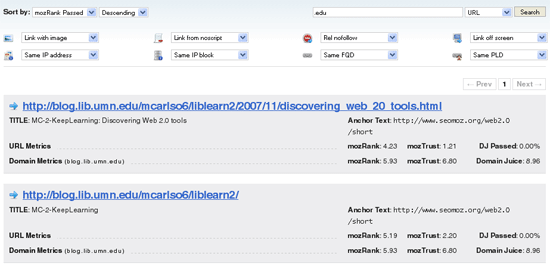
If you're trying to identify links from particular domains, whether those are educational or government or from specific country-code TLDs, Linkscape's search function via the URL is a great resource.
5 General Notes on the Links in Linkscape
- Linkscape's current index is between 1/3-1/2 the major indices at Yahoo! & Google, and it's biased towards domain diversity over depth, so while you'll see tons of different domains and their homepages and important inner pages, you often won't find deep pages on those sites.
- Linkscape data is between 1-2 months old at any given time, so the links aren't always completely fresh.
- Linkscape now shows, by default, the top 3,000 links to a page and domain for every advanced report. The anchor text metrics and the juice passed numbers are based on these 3,000 shown.
- For that 3,000 number, we've elected to show up to 10 links from each domain, again favoring displaying domain diversity. We had lots of folks request this feature before the update last week, but it does mean that many links from a single domain aren't shown.
- The metrics we're happiest with are URL mozRank, URL mozTrust and Domain mozRank. Domain Juice, mozRank passed, and Domain mozTrust are still a little behind, so if you're wondering what metrics to use, go with the former. Link counts and domain counts are also very good.
Whew! That's a lot of material, but I think (nearly) all of it is incredibly valuable for many SEO campaigns. If there are any applications you've employed (or would like to learn more about), please do share!



Comments
Please keep your comments TAGFEE by following the community etiquette
Comments are closed. Got a burning question? Head to our Q&A section to start a new conversation.